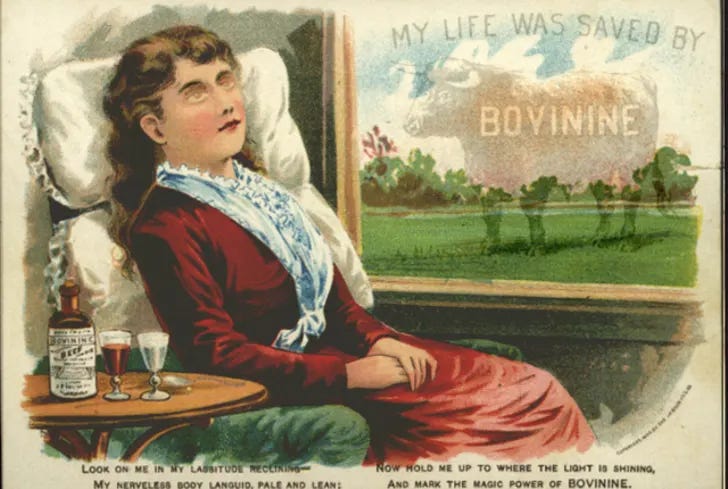"I would rather have questions than can't be answered than answers that can't be questioned." -Richard Feynman
Throughout the pandemic, the motto of "follow the science" seems not to encourage the healthy debate among the large body of thousands of scientists working on COVID-related research, who have a wide variety of opinions according to the various experiences. What it does do is keep eyeballs pointed where media points them---in polar unity toward political leaders and public health authorities.
Public health emerged from, but is not simply, "the recognized authorities from within the scientific community." The scientific community doesn't really take part in the selection process, and it is unclear exactly how nominal its input might be. If scientists I know are representative of the broader community, many of them are perpetually disgusted by it.
To best understand the evolution of public health...authoritarianism...in its present day form, let's take a walk down the history of public health challenges.
During the Black Death of the fourteenth century that killed tens or hundreds of millions around the world (but primarily in Europe), many medical "experts" became caught up in the shared delusion that poisoned air (miasma) caused what has most often since been explained as bubonic plague. This delusion may have kept doctors from testing teas and extracts that might have had balm of Gilead-like antibiotic properties, or otherwise recognizing the conditions under which the illness thrived. Attempted solutions instead focused on the miasma theory including aromatherapy, washing with pee and poop, rubbing wounds with live chickens, and when all else failed, killing some Jews.
The bubonic plague popped up in more localized epidemics continually for centuries in Europe, eventually leading to the seventeenth century plague doctor costumes that were the first attempt at biohazard suits. The function of the beak was to store a combination of herbs that were sometimes even set afire, making the costume something like a pipe smoking experience. To this day, neither the FDA nor any other health organization has run RCTs to "prove" the ineffectiveness of the plague doctor outfits, so they could perhaps see a resurgence as the COVID-19 pandemic continues.
Anyone who knows the history of patent medicine (primarily Europe, but also American) knows that having a central authority decree intellectual property rights to medicines did not mean they were in any way effective. That history might be funny were it not so tragic.
Duke University Digital Collection
Defenders of public health authorities sometimes point to the great success of Scottish-born physician James Lind. In 1747, Lind conducted what is often referred to as the first controlled clinical trial in testing various potential cures for scurvy on stricken seamen, finding that fruits such as lemons and oranges that were full of vitamin C cured and prevented the condition. While historically, Lind was elevated to the status of "founder of naval hygiene" by the English, he was simply the physician who stepped forward to try a solution that many others expected would work for centuries. However, careful historians point out both that there is no evidence that Lind performed his storied experiment (that's okay, health official bandwagoneers, Wikipedia will keep propagating your myths). In fact, amusingly, the notion that a clinical trial would demonstrate the point seems to have been a concoction of the clever salesmen crafting the tale, not one of the influential physicians of the time. To make matters worse, this story appears at the end of two-and-a-half centuries of major European voyages during which many ship captains and their surgeons figured the scurvy solution puzzle out, but were repeatedly dismissed by higher authorities and physician groupthink who often insisted that scurvy was a "disgrace of bad organization" and that lemons were a waste of valuable cargo space.
In 1622, explorer Sir Richard Hawkins wrote, "sower lemons and oranges" were "most fruitful… I wish that some learned men would write of it..." In fact, it seems that in 1593, his crewmen (who were not expected to be of great education or intelligence) seemed to understand the relationship between fruit and scurvy:
“There was great joy amongst my company and many with the sight of the oranges and lemons seemed to recover heart. This is a wonderful secret of the power and wisdom of God that hath hidden so great and unknown virtue in this fruit to be a certain remedy for this infirmity [scurvy].”
Understanding of how to avoid and treat scurvy went at least as far back as Vasco da Gama in the late fifteenth century. As such, you wouldn't expect that two million sailors would die of scurvy over the next three centuries. The numbers often outpaced combat fatalities by almost as much as a hundred-fold. Yet, influential physicians of the day kept scuttling empiric medicine. As Jeremy Hugh Baron wrote in Nutrition Reviews,
Yet orthodox physicians, such as Thomas Willis, Gideon Harvey, Boerhaave, Meade, and Cullen, wrote copiously and learnedly about scurvy, but without any maritime experience, simply listing the many standard theories of the cause of scurvy, and the many standard medical treatments such as bleeding, purging, and polypharmacy. Many of them mentioned treatment with oranges and lemons but without making it clear that sailors and ships' surgeons had long been satisfied that citrus fruits were specific prophylactics and cures for scurvy.
Scurvy caused so many deaths that major expeditions were sometimes crewed with invalids and men (boys) so young they had no experience at all. No wonder so many sailors mutinied in preference of dangerous lives of piracy.
If all that weren't bad enough, scurvy returned among British sailors when in 1875, lime juice was substituted for lemon juice in an act of deadly internal administrative incompetence, dooming more sailors to disease. It wasn't until a full and valid animal model of scurvy was produced in the early twentieth century that all doubt was laid to rest.
If you hope that scurvy wasn't the only example of curative treatments ignored for over a century while millions suffered and died, don't read about cholera. Stop here. Turn back. Read no further.
During the cholera epidemic of the mid-1800s, millions of people died all over the world. In 1832, The Lancet published two articles on saline treatments (O'Shaughnessy and Latta), yet it wasn't until 1953 that "oral rehydration solution" was accepted as a standard of care (Chatterjee, again published by The Lancet).
In 1831, O'Shaughnessy [12] analyzed the blood and stool specimens of patients with cholera and concluded that death was caused by a loss of water and salt. His recommendation that fluid replacement therapy be “effected by injection of powerful ... salts directly into the veins” [12, p. 370] was probably the first therapy derived from experimental data. Latta [13], in 1832, concluded that saline provided orally or by enemas was either “useless or harmful,” and he administered fluids intravenously, resulting in remarkable recovery of moribund patients. Despite these impressive early advances, cathartics and bloodletting prevailed throughout the 19th century. Cholera's mortality rate often exceeded 70%
It turns out that salt and water alone can reduce mortality by as much as 80%. In the meantime, people burned entire towns to the ground trying to stop the outbreaks. Of course, despite the disaster of ignored solutions (pun intended), Wikipedia again fails to mention the history of available treatments ignored by the senior medical bodies of the times. Huh.
I would be remiss if I didn't mention the episode of British physician John Snow. Dr. Snow suspected correctly that cholera was spread through contaminated water, and kept fastidious notes consistent with his theory. In the end, his efforts, while published, were summarily dismissed by medical authorities who stated that he could "furnish no proof whatever of the correctness of his views."
There are many accounts of the various failures by authorities during the Spanish flu, so I'll make this one brief and topical. During the first months of the pandemic that claimed perhaps 50 million lives globally, some physicians figured out that intravenous quinine worked well as a treatment. Sadly, such empiric medicine was never recognized and put widely into practice. Strangely, almost nobody even knows it happened, despite medical records kept. And, of course, Wikipedia doesn't mention quinine in any way other than in a list of "a random assortment of medicines" that were tried while tens of millions perished.
Maybe we should talk about vaccines now, though long articles and entire books have been written about those many stumbles. In 1955, in what is known as "the Cutter incident", the U.S. government issued pharmaceutical manufacturer Cutter Laboratories a license to distribute the stocks it produced of Salk's polio vaccine. Despite passing safety tests, 120,000 doses of the vaccine contained live virus, and over 40,000 recipients suffered varying levels of poliomyelitis. At least five died.
Closer to the modern era we can point to the story of how the sugar industry corrupted science and "snuck by" the health authorities to addict Americans to a slow poison. Even former Gilead chairman Donald Rumsfeld got in on that action with aspartame. As an added bonus to the disturbing trends of sugar-heavy American diets, scurvy is now returning. Buy hey, health authorities have your back.
In an attempt to conjure the image of the noble savage, defenders of public health regimes point to the history of shamans as cultural health "officials". Though, as Stanford Professor Robert Sapolsky points out, shamans are the accepted outsiders of the tribe, very possibly schizotypals. As such, shamans are the furthest from being influenced by politics and groupthink out of everyone in the tribe---hard to trap into groupthink due both to their independence (or at least distance) and also to their nature of handling multiple wavelengths of thought. They might be counted on as the healers, but perhaps precisely because they are the antithesis of public health authorities who seem historically entangled in an anti-scientific game of establishing consensus (if not simply following the...following the...the money), which is only a reasonable strategy if ass covering is the primary goal.
Today, the health experts tasked at the political levels of the United States (and by chance those nations closest to its sphere of influence) are failing us by dismissing an avalanche of evidence of effective empiric COVID-19 treatments, primarily at the early stages of disease. But you don't have to take my word for it. Here is Peter McCullough, the world's most published medical doctor, on "therapeutic nihilism":
Finally, if you are interested in further reading on this point, I recommend The Dossier's excellent article.









Excellent!
There is something mildly hilarious that the last item, the video with Dr. McCullough has been removed for violating the YouTube terms of service. Or it might be hysteria and not hilarity idk